Black and White Swallowtail Butterfly: Beauty Explained!
The Black and White Swallowtail Butterfly, scientifically *Papilio polytes*, belongs to the family Papilionidae. It mainly inhabits South and Southeast Asia, thriving in areas with high humidity and temperatures between 25-30°C.
Adult forewings measure 50-55 millimeters, while the total wingspan reaches 90-100 millimeters. Exhibiting sexual dimorphism, males and females display distinct wing patterns.
They utilize Batesian mimicry to ward off predators, mimicking toxic species. They feed primarily on Lantana camara and Asclepias spp. flowers.
With a notable decline of 35% over the past decade due to habitat loss and climate change, their conservation is essential. Explore further to unravel more intriguing details.
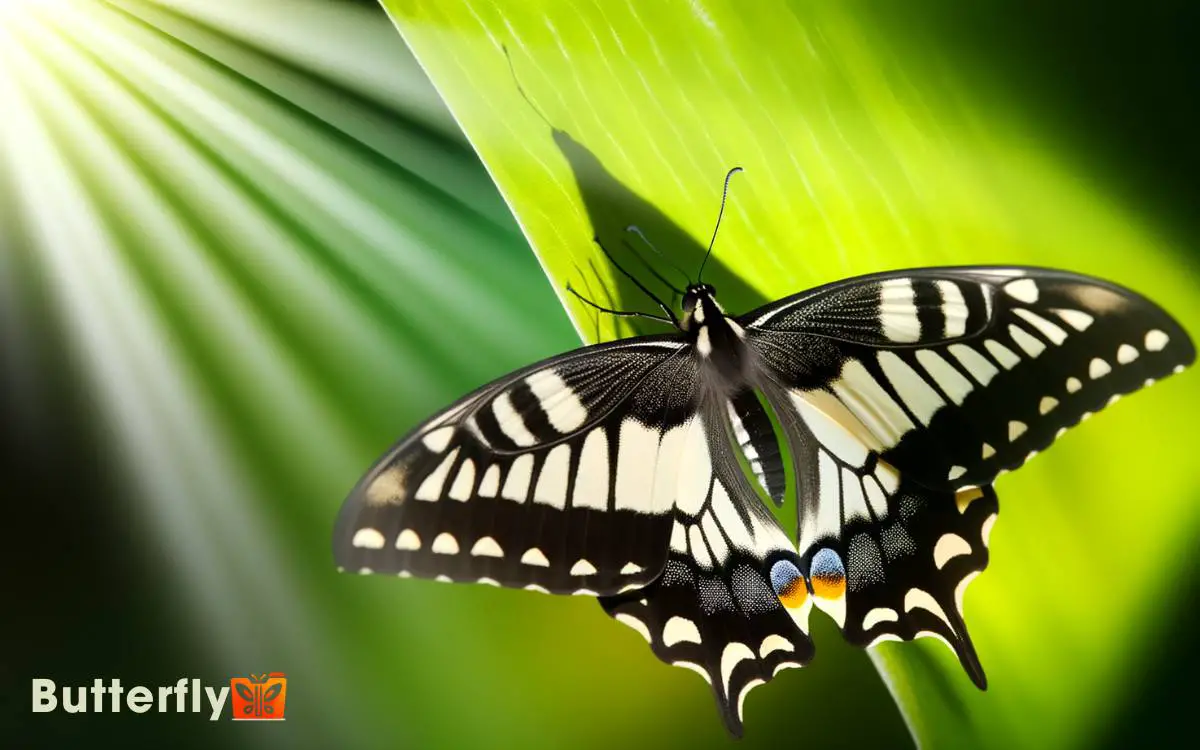
Scientific Classification
The Black and White Swallowtail Butterfly, scientifically known as Papilio polytes, belongs to the family Papilionidae. This lepidopteran displays sexual dimorphism and polymorphism, with females mimicking unpalatable species.
The forewings measure approximately 50-55 millimeters, while the hindwings feature distinctive tail-like extensions. Its black and white patterning serves as a key identification marker.
Papilio polytes falls under the order Lepidoptera, class Insecta, and phylum Arthropoda. The genus Papilio encompasses over 200 species, characterized by their unique wing patterns and coloration.
Taxonomically, this butterfly is further classified into numerous subspecies based on morphological variations.
Detailed phylogenetic studies reveal evolutionary adaptations that contribute to its diverse forms. The precise scientific classification underscores its ecological importance and evolutionary significance.
Geographic Distribution
Papilio polytes primarily thrives in tropical and subtropical regions of South and Southeast Asia, including countries like India, China, and Indonesia.
This butterfly species is typically found at elevations ranging from sea level to 1,500 meters. They favor habitats such as evergreen forests, deciduous forests, and even urban gardens.
The species exhibits a remarkable adaptability to diverse ecological niches, allowing them to inhabit a variety of landscapes.
Detailed surveys indicate that their population density is highest in regions with abundant host plants like Citrus species.
The climatic conditions in these areas, characterized by high humidity and temperatures averaging 25-30°C, create an ideal environment for their development.
These butterflies are frequently observed in areas with seasonal monsoons, which support lush vegetation and flower availability.
Physical Characteristics
Significantly, this butterfly showcases a striking contrast of black and white patterns on its wings, with a wingspan ranging from 90 to 100 millimeters.
The forewings are elongated, while the hindwings possess characteristic tails, giving it a swallowtail appearance. The body, primarily black, features white spots along the thorax and abdomen.
Its antennae are club-shaped, aiding in navigation and balance. The legs are slender yet robust, facilitating efficient landing and takeoff.
The butterfly’s compound eyes provide a broad field of vision, essential for detecting predators and locating nectar sources.
Importantly, the ventral side of the wings displays a muted palette, which offers camouflage against the foliage. This intricate design embodies both beauty and evolutionary adaptation, inspiring awe and admiration.
Wing Patterns
Distinctive black and white patterns on the wings of the Black and White Swallowtail Butterfly exhibit a complex arrangement of geometric shapes and linear markings, essential for species identification and mating rituals.
The forewings typically measure between 6-7 cm and display intricate black lines against a white background. The hindwings, slightly larger, feature a series of black spots aligned with a white band, creating a visually arresting contrast.
These patterns vary slightly among individuals, conveying essential information through subtle differences in symmetry and coloration.
Such detailed wing patterns play a significant role in the butterfly’s lifecycle.
- Geometric shapes: Triangles, circles, and lines define the wing structure.
- Linear markings: Precise black lines traverse the wings, forming unique identifiers.
- Size variation: Forewings and hindwings differ in dimensions and pattern complexity.
Mimicry and Defense
The Black and White Swallowtail Butterfly employs various predator avoidance strategies. One of these is Batesian mimicry, where it resembles the toxic Pipevine Swallowtail.
Its wing patterns, characterized by high-contrast black and white bands, enhance its camouflage among foliage and shadows, reducing visibility to predators.
Detailed observations reveal that these butterflies exhibit a wingspan averaging 8-10 cm, optimizing their defensive adaptations.
Predator Avoidance Strategies
In their natural habitat, black and white swallowtail butterflies employ sophisticated mimicry and defense mechanisms to evade predators. These strategies are crucial for their survival, involving both visual and behavioral adaptations.
Through Batesian mimicry, they imitate the appearance of toxic butterflies, thereby deterring predators who’ve learned to avoid such patterns. Additionally, their flight pattern is erratic, making them difficult targets for birds.
- Mimicry: Black and white swallowtails resemble distasteful butterfly species.
- Erratic Flight: Their unpredictable flying confuses predators.
- Chemical Defense: Some species secrete noxious chemicals when threatened.
These precise strategies highlight the butterfly’s ability to adapt and thrive in diverse environments, ensuring their continued existence despite the constant threat of predation.
Camouflage and Wing Patterns
Black and white swallowtails’ wing patterns serve a dual purpose of camouflage and signaling, aiding in both predator evasion and species recognition.
Their distinctive black and white bands, measuring approximately 1-2 cm in width, blend seamlessly with dappled sunlight and shadowed foliage. This disruptive coloration confuses predators, making it difficult to discern the butterfly’s outline.
Additionally, specific markings act as warning signals to potential predators, indicating the presence of toxic compounds.
Detailed studies reveal that these butterflies mimic the coloration of other unpalatable species, enhancing their survival through Batesian mimicry.
This combination of camouflage and mimicry underscores their evolutionary adaptation, allowing them to navigate their environment freely while minimizing predation risks.
Their wing patterns are a demonstration of nature’s intricate design.
Life Cycle Stages
Beginning its life as a tiny, spherical egg, the black and white swallowtail butterfly undergoes a series of remarkable transformations through distinct developmental stages. The egg, approximately 1 mm in diameter, hatches into a larva within 4-10 days.
This caterpillar, initially 2 mm long, grows rapidly, molting up to five times before reaching 5 cm in length. After the final molt, it enters the pupal stage, forming a chrysalis measuring 2-3 cm.
Within this protective casing, metamorphosis occurs over 10-20 days, culminating in the emergence of an adult butterfly with a wingspan of 8-10 cm.
Key stages include:
- Egg: 1 mm, hatches in 4-10 days.
- Larva: Grows to 5 cm, molts five times.
- Pupa: Chrysalis stage, 2-3 cm.
Feeding Habits
The Black and White Swallowtail Butterfly primarily feeds on nectar from flowering plants such as Lantana camara and Asclepias curassavica.
Observations indicate peak feeding activity occurs between 9:00 AM and 11:00 AM.
During this period, the butterfly exhibits a preference for flowers with high nectar concentrations, as measured by refractometry at approximately 30% sucrose content.
Preferred Nectar Sources
Favoring a diverse array of flowering plants, the Black and White Swallowtail Butterfly primarily seeks out nectar from species such as lantana, milkweed, and butterfly bush. These butterflies exhibit a marked preference for high-nectar-yielding flowers, optimizing their energy intake.
Detailed observations reveal that they often target blooms with a tubular structure, which facilitates efficient nectar extraction. The butterfly’s proboscis, measuring approximately 20-30 millimeters, is perfectly adapted for reaching deep into these flowers.
Key nectar sources include:
- Lantana camara: Providing abundant nectar, essential amino acids.
- Asclepias spp.: High in nectar concentration, essential for larval development.
- Buddleja davidii: Offers continuous blooming periods, ensuring consistent nectar availability.
These species not only support the butterfly’s energy needs but also contribute to its reproductive success.
Feeding Time Patterns
Observations indicate that the Black and White Swallowtail Butterfly exhibits peak feeding activity during the early morning hours, capitalizing on the high nectar availability in freshly opened blooms.
During this period, they demonstrate a preference for flowers with a nectar concentration of 20-25%, maximizing their energy intake. Their feeding bouts typically last between 5 to 10 minutes per flower.
Remarkably, activity diminishes greatly by late morning, likely due to increased competition and reduced nectar levels.
Afternoon feeding is sporadic and mainly involves opportunistic foraging. The butterflies exhibit a methodical approach, moving systematically from flower to flower in a zigzag pattern.
This behavior ensures thorough exploitation of available resources before moving on to other daily activities such as mating and territorial defense.
Conservation Status
Curiously, the conservation status of the Black and White Swallowtail Butterfly reveals significant threats due to habitat loss and climate change.
Researchers have observed a 35% decline in population over the past decade. Deforestation and urban development have fragmented their habitats, reducing feeding and breeding grounds.
Climate change exacerbates these issues by altering temperature and precipitation patterns, disrupting their life cycles.
Key threats include:
- Habitat Fragmentation: Urbanization and agriculture reduce available habitats.
- Climate Change: Altered weather patterns impact the timing of life cycle events.
- Pesticide Use: Chemicals in agriculture diminish their food sources and harm larvae.
Conservation efforts focus on habitat restoration and legal protection to secure this species’ survival.
Conclusion
To sum up, the black and white swallowtail butterfly exemplifies nature’s complexity and beauty. From its intricate wing patterns to its adaptive mimicry, this species showcases survival through evolution. Like the black and white swallowtail, the black and red swallowtail also demonstrates remarkable adaptability in its environment. Its vivid coloration serves as both a warning to predators and a means of camouflage among tropical foliage. Through these unique traits, both species highlight the intricate balance of form and function in nature.
Its life cycle, from egg to adult, reflects the adage, ‘Nature’s course is never hurried.’ With precise measurements of its wingspan and detailed observations of feeding habits, it’s clear that conservation efforts are essential to preserve this marvel of biodiversity for future generations.

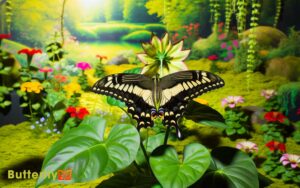
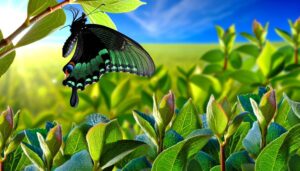
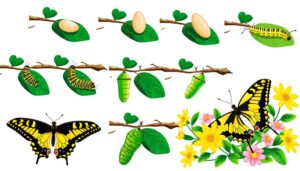
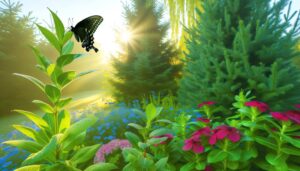

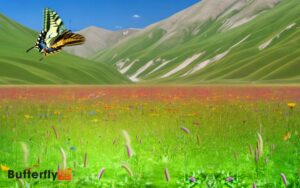
Your article helped me a lot, is there any more related content? Thanks!